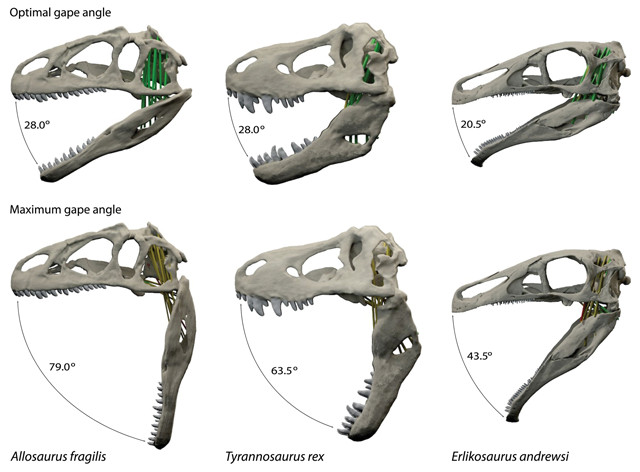
by Mary Caperton Morton Friday, February 19, 2016

T. rex was a fearsome predator with the jaws to match. Credit: Stephan Lautenschlager, University of Bristol.
Tyrannosaurus rex is often depicted with its fearsome jaws wide open, but few studies have looked at how wide the Cretaceous predator’s gape could actually be. In a new study, Stephan Lautenschlager of the University of Bristol in England looked at theropod jaws, including that of T. rex, to study how the feeding styles and dietary preferences of dinosaurs were linked to how wide they could open their mouths.
Lautenschlager compared the skulls of three distinct theropods: T. rex, a large meat-eater with massive jaws, Allosaurus fragilis, a more lightly built predator, and Erlikosaurus andrewsi, a closely related but herbivorous member of the theropod family. Using digital models and computer simulations, he studied the muscle strain that would have been generated when each of the jaws was opened wide.
“All muscles, including those used for closing and opening the jaw, can only stretch a certain amount before they tear. This considerably limits how wide an animal can open its jaws and therefore how and on what it can feed,” Lautenschlager said in a statement.
While carnivorous T. rex and Allosaurus could open their jaws wide, perhaps up to 90 degrees, the herbivore Erlikosaurus could only stretch to about 45 degrees, Lautenschlager reported in the journal Royal Society Open Science. The two carnivores differed from one another in their sustained bite force, with T. rex producing a more powerful bite over a wider range of jaw angles than Allosaurus.
“We know from living animals that carnivores are usually capable of larger jaw gapes than herbivores, and it is interesting to see that this also appears to be the case in theropod dinosaurs,” Lautenschlager said.
© 2008-2021. All rights reserved. Any copying, redistribution or retransmission of any of the contents of this service without the expressed written permission of the American Geosciences Institute is expressly prohibited. Click here for all copyright requests.